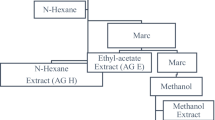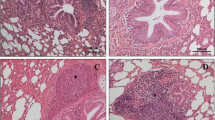Abstract
Ipomoea carnea has been held responsible for several poisoning episodes, mainly in goats. This plant contains swainsonine, which inhibits acid or lysosomal α-mannosidase enzyme, causing cellular vacuolization. The objective of this study was to evaluate I. carnea toxicosis when four different doses of this plant were fed to growing goats. Twenty-five male goats were divided into five groups, one control group and four experimental groups that received 2.5, 5.0, 10.0 and 30.0 g of the plant per kg of live weight per day for 4 months. Blood samples were collected for haematological and biochemical determinations and fragments from some tissues were collected for histopathological study. All the experimental goats ingested the plant throughout the trial, presenting nystagmus, muscle tremors, weakness of the hind limbs and ataxia. They also had a significant increase in alanine aminotransferase (ALT) from the sixth week of the experiment compared to the goats in the control group. There was a significant reduction in haemoglobin concentration in the goats treated with I. carnea. Histopathology revealed degenerative vacuolar alterations in the liver, pancreas, thyroid and kidney cells, and in the neurons of the central nervous system in the animals that received the plant. All these alterations occurred in a dose-dependent manner.
Similar content being viewed by others
REFERENCES
Alroy, J., Orgad, V., Ucci, A.A. and Pereira, M.E.A., 1984. Identification of glycoprotein storage diseases by lectins. A new diagnostic method. Journal of Histochemistry and Cytochemistry, 32, 1280-1284
Asano, N., Kato, A., Oseki, K., Kizu, H. and Matsui, K., 1995. Calystegins of Physalis alkekengi var. francheti (Solanaceae). Structure determination and their glycosidase inhibitory activities. European Journal of Biochemistry, 229, 369-376
Asano, N., Nash, R.J., Molyneux, R.J. and Fleet, G.N.J., 2000. Sugar-mimic glycosidase inhibitors: natural occurrence, biological activity and prospects for therapeutic application. Tetrahedron Asymmetry, 11, 1645-1680
Damir, A., Adam, S.E.I. and Tartour, G., 1987. The effects of Ipomoea carnea on goats and sheep. Veterinary and Human Toxicology, 29, 316-319
De Balogh, K.I.M., Dimande, A.P., Van Der Lugt, J.J., Molyneux, R.J., Naudé, T.W. and Welman, W.G., 1999. A lysosomal storage disease induced by Ipomoea carnea in goats in Mozambique. Journal of Veterinary Diagnostic Investigation, 11, 266-273
Elbein, A.D., 1989. The effects of plant indolizidine alkaloids and related compounds in glycoprotein processing. In: L.F. James, A.D. Elbein, R.J. Molyneux and C.D. Warren (eds), Swainsonine and Related Glycosidase Inhibitors, (Iowa University Press, Ames, IA), 155-187
Idris, O.F., Tartour, G., Adam, S.E.I. and Obeid, H.M., 1973. Toxicity to goats of Ipomoea carnea. Tropical Animal Health and Production, 5, 110-123
Jolly, R.D. and Blakemore, W.F., 1973. Inherited lysosomal storage diseases: an essay in comparative medicine. The Veterinary Record, 13, 391-400
King, N.W. and Alroy, J., 2000. Deposições intracelulares e extracelulares: degenerações. In: T.C. Jones, R.D. Hunt and N.W. King (eds), Patologia Veterinãria, 6th edn, (Manole, São Paulo), 27-61
Klein, J.L., Roberts, J.D., George, M.D., Kurtzberg, J., Breton, P., Chermann, J.C. and Olden, B.R.K., 1999. Swainsonine protects both murine and human haematopoietic systems from chemotherapeutic toxicity. Journal of Cancer, 80, 87-95
Pritchard, R.H., Huxtable, C.R.R. and Dorling, P.R., 1990. Swainsonine toxicosis suppresses appetite and retards growth in weanling rats. Research in Veterinary Science, 48, 288-293
Srilatha, C.H., Gopal Naidu, N.R. and Rama Rao, P., 1997. Pathology of Ipomoea carnea toxicity in goats. Indian Journal of Animal Sciences, 67, 253-254
Stevens, K.R. and Gallo, M.A., 1989. Practical considerations in the conduct of chronic toxicity studies. In: A.W. Hayes (ed.), Principles and Methods of Toxicology, 2nd edn, (Raven Press, New York), 237-250
Tartour, G., Adam, S.E.I., Obeid, H.M. and Idris, O.F., 1974. Development of anaemia in goats fed with Ipomoea carnea. British Veterinary Journal, 130, 271-279
Tirkey, K., Yadava, K.P. and Mandal, T.K., 1987. Effect of aqueous extract of Ipomoea carnea on the haematological and biochemical parameters in goats. Indian Journal of Animal Sciences, 57, 1019-1023
Tokarnia, C.H., Döbereiner, J. and Canella, C.F.C., 1960. Estudo experimental sobre a toxidez do “canudo” (Ipomoea fistulosa Mart.) em ruminantes. Arquivos do Instituto de Biologia Animal, 3, 59-71
Author information
Authors and Affiliations
Rights and permissions
About this article
Cite this article
Schumaher-Henrique, B., Górniak, S., Dagli, M. et al. The Clinical, Biochemical, Haematological and Pathological Effects of Long-Term Administration of Ipomoea carnea to Growing Goats. Vet Res Commun 27, 311–319 (2003). https://doi.org/10.1023/A:1024036225641
Issue Date:
DOI: https://doi.org/10.1023/A:1024036225641




